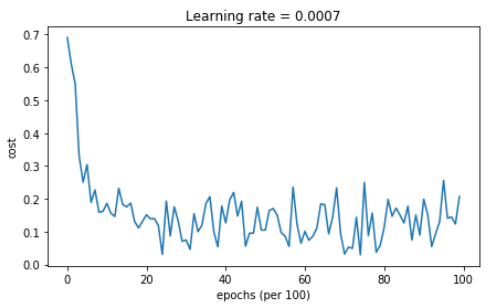(批量)梯度下降法


1 import numpy as np 2 import matplotlib.pyplot as plt 3 import scipy.io 4 import math 5 import sklearn 6 import sklearn.datasets 7 8 from opt_utils import load_params_and_grads, initialize_parameters, forward_propagation, backward_propagation 9 from opt_utils import compute_cost, predict, predict_dec, plot_decision_boundary, load_dataset 10 from testCases_v3 import * 11 12 # %matplotlib inline 13 plt.rcParams['figure.figsize'] = (7.0, 4.0) # set default size of plots 14 plt.rcParams['image.interpolation'] = 'nearest' 15 plt.rcParams['image.cmap'] = 'gray' 16 17 18 # GRADED FUNCTION: update_parameters_with_gd 19 def update_parameters_with_gd(parameters, grads, learning_rate): 20 """ 21 Update parameters using one step of gradient descent 22 23 Arguments: 24 parameters -- python dictionary containing your parameters to be updated: 25 parameters['W' + str(l)] = Wl 26 parameters['b' + str(l)] = bl 27 grads -- python dictionary containing your gradients to update each parameters: 28 grads['dW' + str(l)] = dWl 29 grads['db' + str(l)] = dbl 30 learning_rate -- the learning rate, scalar. 31 32 Returns: 33 parameters -- python dictionary containing your updated parameters 34 """ 35 36 L = len(parameters) // 2 # number of layers in the neural networks 37 38 # Update rule for each parameter 39 for l in range(L): 40 ### START CODE HERE ### (approx. 2 lines) 41 parameters['W'+str(l+1)]=parameters['W'+str(l+1)]-learning_rate*grads['dW'+str(l+1)] 42 parameters['b'+str(l+1)]=parameters['b'+str(l+1)]-learning_rate*grads['db'+str(l+1)] 43 ### END CODE HERE ### 44 45 return parameters
批量梯度下降(mini-batch size=m)
随机梯度下降(mini-batch size=1)

1 #(Batch) Gradient Descent: 2 X = data_input 3 Y = labels 4 parameters = initialize_parameters(layers_dims) 5 for i in range(0, num_iterations): 6 # Forward propagation 7 a, caches = forward_propagation(X, parameters) 8 # Compute cost. 9 cost = compute_cost(a, Y) 10 # Backward propagation. 11 grads = backward_propagation(a, caches, parameters) 12 # Update parameters. 13 parameters = update_parameters(parameters, grads) 14 15 #Stochastic Gradient Descent: 16 X = data_input 17 Y = labels 18 parameters = initialize_parameters(layers_dims) 19 for i in range(0, num_iterations): 20 for j in range(0, m): 21 # Forward propagation 22 a, caches = forward_propagation(X[:,j], parameters) 23 # Compute cost 24 cost = compute_cost(a, Y[:,j]) 25 # Backward propagation 26 grads = backward_propagation(a, caches, parameters) 27 # Update parameters. 28 parameters = update_parameters(parameters, grads)
mini-batch梯度下降
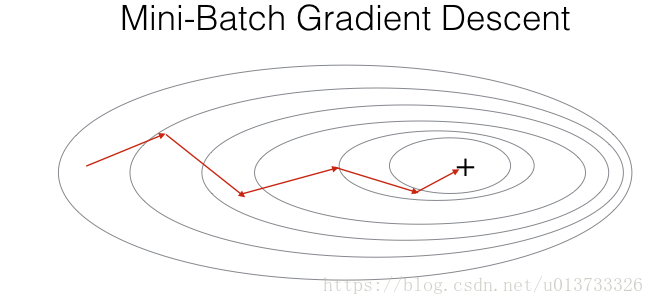

图中直接按训练集的原顺序分割,代码中先使用permutation函数打乱后再分割。

1 def random_mini_batches(X, Y, mini_batch_size = 64, seed = 0): 2 """ 3 Creates a list of random minibatches from (X, Y) 4 5 Arguments: 6 X -- input data, of shape (input size, number of examples) 7 Y -- true "label" vector (1 for blue dot / 0 for red dot), of shape (1, number of examples) 8 mini_batch_size -- size of the mini-batches, integer 9 10 Returns: 11 mini_batches -- list of synchronous (mini_batch_X, mini_batch_Y) 12 """ 13 14 np.random.seed(seed) # To make your "random" minibatches the same as ours 15 m = X.shape[1] # number of training examples 16 mini_batches = [] 17 18 # Step 1: Shuffle (X, Y) 19 permutation = list(np.random.permutation(m)) 20 shuffled_X = X[:, permutation] 21 shuffled_Y = Y[:, permutation].reshape((1,m)) 22 23 # Step 2: Partition (shuffled_X, shuffled_Y). Minus the end case. 24 num_complete_minibatches = math.floor(m/mini_batch_size) # number of mini batches of size mini_batch_size in your partitionning 25 for k in range(0, num_complete_minibatches): 26 ### START CODE HERE ### (approx. 2 lines) 27 mini_batch_X=shuffled_X[:,k*mini_batch_size:(k+1)*mini_batch_size] 28 mini_batch_Y=shuffled_Y[:,k*mini_batch_size:(k+1)*mini_batch_size] 29 ### END CODE HERE ### 30 31 mini_batch = (mini_batch_X, mini_batch_Y) 32 mini_batches.append(mini_batch) 33 34 # Handling the end case (last mini-batch < mini_batch_size) 35 if m % mini_batch_size != 0: 36 ### START CODE HERE ### (approx. 2 lines) 37 mini_batch_X=shuffled_X[:,mini_batch_size * num_complete_minibatches:] 38 mini_batch_Y=shuffled_Y[:,mini_batch_size * num_complete_minibatches:] 39 ### END CODE HERE ### 40 41 mini_batch = (mini_batch_X, mini_batch_Y) 42 mini_batches.append(mini_batch) 43 44 return mini_batches
动量梯度下降法

初始化参数

1 def initialize_velocity(parameters): 2 """ 3 Initializes the velocity as a python dictionary with: 4 - keys: "dW1", "db1", ..., "dWL", "dbL" 5 - values: numpy arrays of zeros of the same shape as the corresponding gradients/parameters. 6 Arguments: 7 parameters -- python dictionary containing your parameters. 8 parameters['W' + str(l)] = Wl 9 parameters['b' + str(l)] = bl 10 11 Returns: 12 v -- python dictionary containing the current velocity. 13 v['dW' + str(l)] = velocity of dWl 14 v['db' + str(l)] = velocity of dbl 15 """ 16 17 L = len(parameters) // 2 # number of layers in the neural networks 18 v = {} 19 20 # Initialize velocity 21 for l in range(L): 22 ### START CODE HERE ### (approx. 2 lines) 23 v['dW'+str(l+1)]=np.zeros_like(parameters['W'+str(l+1)]) 24 v['db'+str(l+1)]=np.zeros_like(parameters['b'+str(l+1)]) 25 ### END CODE HERE ### 26 27 return v
更新参数

1 def update_parameters_with_momentum(parameters, grads, v, beta, learning_rate): 2 """ 3 Update parameters using Momentum 4 5 Arguments: 6 parameters -- python dictionary containing your parameters: 7 parameters['W' + str(l)] = Wl 8 parameters['b' + str(l)] = bl 9 grads -- python dictionary containing your gradients for each parameters: 10 grads['dW' + str(l)] = dWl 11 grads['db' + str(l)] = dbl 12 v -- python dictionary containing the current velocity: 13 v['dW' + str(l)] = ... 14 v['db' + str(l)] = ... 15 beta -- the momentum hyperparameter, scalar 16 learning_rate -- the learning rate, scalar 17 18 Returns: 19 parameters -- python dictionary containing your updated parameters 20 v -- python dictionary containing your updated velocities 21 """ 22 23 L = len(parameters) // 2 # number of layers in the neural networks 24 25 # Momentum update for each parameter 26 for l in range(L): 27 28 ### START CODE HERE ### (approx. 4 lines) 29 # compute velocities 30 v["dW" + str(l + 1)] = beta * v["dW" + str(l + 1)] + (1 - beta) * grads['dW' + str(l + 1)] 31 v["db" + str(l + 1)] = beta * v["db" + str(l + 1)] + (1 - beta) * grads['db' + str(l + 1)] 32 # update parameters 33 parameters["W" + str(l + 1)] = parameters["W" + str(l + 1)] - learning_rate * v["dW" + str(l + 1)] 34 parameters["b" + str(l + 1)] = parameters["b" + str(l + 1)] - learning_rate * v["db" + str(l + 1)] 35 ### END CODE HERE ### 36 37 return parameters, v
Adam优化算法
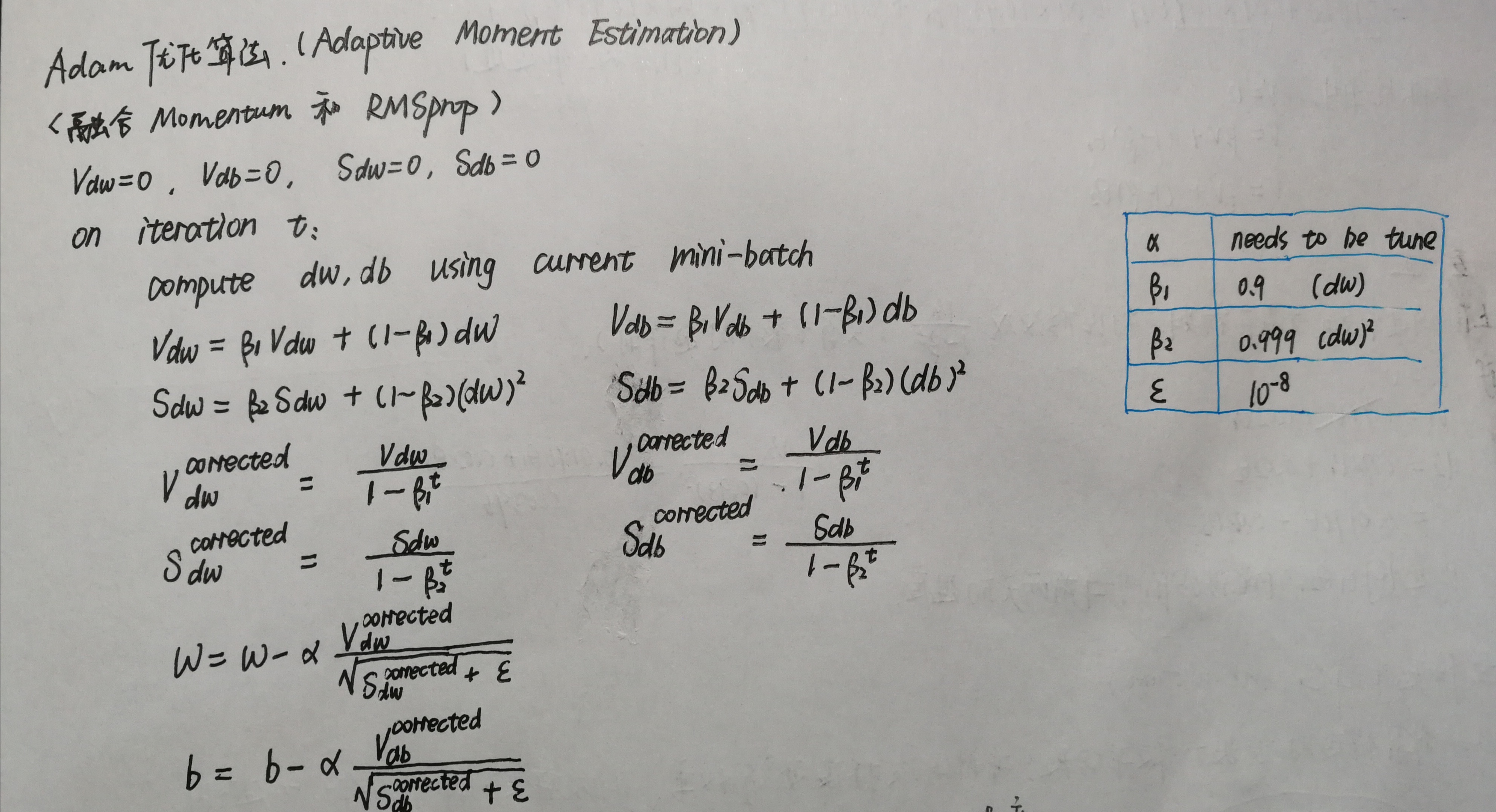
初始化参数

1 def initialize_adam(parameters) : 2 """ 3 Initializes v and s as two python dictionaries with: 4 - keys: "dW1", "db1", ..., "dWL", "dbL" 5 - values: numpy arrays of zeros of the same shape as the corresponding gradients/parameters. 6 7 Arguments: 8 parameters -- python dictionary containing your parameters. 9 parameters["W" + str(l)] = Wl 10 parameters["b" + str(l)] = bl 11 12 Returns: 13 v -- python dictionary that will contain the exponentially weighted average of the gradient. 14 v["dW" + str(l)] = ... 15 v["db" + str(l)] = ... 16 s -- python dictionary that will contain the exponentially weighted average of the squared gradient. 17 s["dW" + str(l)] = ... 18 s["db" + str(l)] = ... 19 20 """ 21 22 L = len(parameters) // 2 # number of layers in the neural networks 23 v = {} 24 s = {} 25 26 # Initialize v, s. Input: "parameters". Outputs: "v, s". 27 for l in range(L): 28 ### START CODE HERE ### (approx. 4 lines) 29 v["dW" + str(l+1)] = np.zeros_like(parameters['W'+str(l+1)]) 30 v["db" + str(l+1)] = np.zeros_like(parameters['b'+str(l+1)]) 31 32 s["dW" + str(l+1)] = np.zeros_like(parameters['W'+str(l+1)]) 33 s["db" + str(l+1)] = np.zeros_like(parameters['b'+str(l+1)]) 34 ### END CODE HERE ### 35 36 return v, s
更新参数

1 def update_parameters_with_adam(parameters, grads, v, s, t, learning_rate=0.01, 2 beta1=0.9, beta2=0.999, epsilon=1e-8): 3 """ 4 Update parameters using Adam 5 6 Arguments: 7 parameters -- python dictionary containing your parameters: 8 parameters['W' + str(l)] = Wl 9 parameters['b' + str(l)] = bl 10 grads -- python dictionary containing your gradients for each parameters: 11 grads['dW' + str(l)] = dWl 12 grads['db' + str(l)] = dbl 13 v -- Adam variable, moving average of the first gradient, python dictionary 14 s -- Adam variable, moving average of the squared gradient, python dictionary 15 learning_rate -- the learning rate, scalar. 16 beta1 -- Exponential decay hyperparameter for the first moment estimates 17 beta2 -- Exponential decay hyperparameter for the second moment estimates 18 epsilon -- hyperparameter preventing division by zero in Adam updates 19 20 Returns: 21 parameters -- python dictionary containing your updated parameters 22 v -- Adam variable, moving average of the first gradient, python dictionary 23 s -- Adam variable, moving average of the squared gradient, python dictionary 24 """ 25 26 L = len(parameters) // 2 # number of layers in the neural networks 27 v_corrected = {} # Initializing first moment estimate, python dictionary 28 s_corrected = {} # Initializing second moment estimate, python dictionary 29 30 # Perform Adam update on all parameters 31 for l in range(L): 32 # Moving average of the gradients. Inputs: "v, grads, beta1". Output: "v". 33 ### START CODE HERE ### (approx. 2 lines) 34 v['dW'+str(l+1)]=beta1*v["dW"+str(l+1)]+(1-beta1)*grads['dW'+str(l+1)] 35 v['db'+str(l+1)]=beta1*v["db"+str(l+1)]+(1-beta1)*grads['db'+str(l+1)] 36 ### END CODE HERE ### 37 38 # Compute bias-corrected first moment estimate. Inputs: "v, beta1, t". Output: "v_corrected". 39 ### START CODE HERE ### (approx. 2 lines) 40 v_corrected['dW'+str(l+1)]=v['dW'+str(l+1)]/(1-beta1**t) 41 v_corrected['db'+str(l+1)]=v['db'+str(l+1)]/(1-beta1**t) 42 ### END CODE HERE ### 43 44 # Moving average of the squared gradients. Inputs: "s, grads, beta2". Output: "s". 45 ### START CODE HERE ### (approx. 2 lines) 46 s['dW'+str(l+1)]=beta2*s["dW"+str(l+1)]+(1-beta2)*(grads['dW'+str(l+1)])**2 47 s['db'+str(l+1)]=beta2*s["db"+str(l+1)]+(1-beta2)*(grads['db'+str(l+1)])**2 48 ### END CODE HERE ### 49 50 # Compute bias-corrected second raw moment estimate. Inputs: "s, beta2, t". Output: "s_corrected". 51 ### START CODE HERE ### (approx. 2 lines) 52 s_corrected['dW'+str(l+1)]=s['dW'+str(l+1)]/(1-beta2**t) 53 s_corrected['db'+str(l+1)]=s['db'+str(l+1)]/(1-beta2**t) 54 ### END CODE HERE ### 55 56 # Update parameters. Inputs: "parameters, learning_rate, v_corrected, s_corrected, epsilon". Output: "parameters". 57 ### START CODE HERE ### (approx. 2 lines) 58 parameters['W'+str(l+1)]=parameters['W'+str(l+1)]-learning_rate*(v_corrected['dW'+str(l+1)]/np.sqrt(s_corrected['dW'+str(l+1)]+epsilon)) 59 parameters['b'+str(l+1)]=parameters['b'+str(l+1)]-learning_rate*(v_corrected['db'+str(l+1)]/np.sqrt(s_corrected['db'+str(l+1)]+epsilon)) 60 ### END CODE HERE ### 61 62 return parameters, v, s
测试
加载数据集
train_X, train_Y = load_dataset()
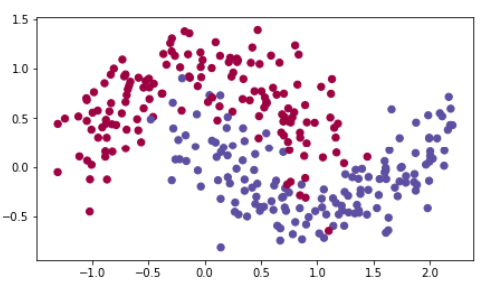
定义模型

1 def model(X, Y, layers_dims, optimizer, learning_rate=0.0007, mini_batch_size=64, beta=0.9, 2 beta1=0.9, beta2=0.999, epsilon=1e-8, num_epochs=10000, print_cost=True): 3 """ 4 3-layer neural network model which can be run in different optimizer modes. 5 6 Arguments: 7 X -- input data, of shape (2, number of examples) 8 Y -- true "label" vector (1 for blue dot / 0 for red dot), of shape (1, number of examples) 9 layers_dims -- python list, containing the size of each layer 10 learning_rate -- the learning rate, scalar. 11 mini_batch_size -- the size of a mini batch 12 beta -- Momentum hyperparameter 13 beta1 -- Exponential decay hyperparameter for the past gradients estimates 14 beta2 -- Exponential decay hyperparameter for the past squared gradients estimates 15 epsilon -- hyperparameter preventing division by zero in Adam updates 16 num_epochs -- number of epochs 17 print_cost -- True to print the cost every 1000 epochs 18 19 Returns: 20 parameters -- python dictionary containing your updated parameters 21 """ 22 23 L = len(layers_dims) # number of layers in the neural networks 24 costs = [] # to keep track of the cost 25 t = 0 # initializing the counter required for Adam update 26 seed = 10 # For grading purposes, so that your "random" minibatches are the same as ours 27 28 # Initialize parameters 29 parameters = initialize_parameters(layers_dims) 30 31 # Initialize the optimizer 32 if optimizer == "gd": 33 pass # no initialization required for gradient descent 34 elif optimizer == "momentum": 35 v = initialize_velocity(parameters) 36 elif optimizer == "adam": 37 v, s = initialize_adam(parameters) 38 39 # Optimization loop 40 for i in range(num_epochs): 41 42 # Define the random minibatches. We increment the seed to reshuffle differently the dataset after each epoch 43 seed = seed + 1 44 minibatches = random_mini_batches(X, Y, mini_batch_size, seed) 45 46 for minibatch in minibatches: 47 48 # Select a minibatch 49 (minibatch_X, minibatch_Y) = minibatch 50 51 # Forward propagation 52 a3, caches = forward_propagation(minibatch_X, parameters) 53 54 # Compute cost 55 cost = compute_cost(a3, minibatch_Y) 56 57 # Backward propagation 58 grads = backward_propagation(minibatch_X, minibatch_Y, caches) 59 60 # Update parameters 61 if optimizer == "gd": 62 parameters = update_parameters_with_gd(parameters, grads, learning_rate) 63 elif optimizer == "momentum": 64 parameters, v = update_parameters_with_momentum(parameters, grads, v, beta, learning_rate) 65 elif optimizer == "adam": 66 t = t + 1 # Adam counter 67 parameters, v, s = update_parameters_with_adam(parameters, grads, v, s, 68 t, learning_rate, beta1, beta2, epsilon) 69 70 # Print the cost every 1000 epoch 71 if print_cost and i % 1000 == 0: 72 print("Cost after epoch %i: %f" % (i, cost)) 73 if print_cost and i % 100 == 0: 74 costs.append(cost) 75 76 # plot the cost 77 plt.plot(costs) 78 plt.ylabel('cost') 79 plt.xlabel('epochs (per 100)') 80 plt.title("Learning rate = " + str(learning_rate)) 81 plt.show() 82 83 return parameters
批量梯度下降
1 # train 3-layer model 2 layers_dims = [train_X.shape[0], 5, 2, 1] 3 parameters = model(train_X, train_Y, layers_dims, optimizer="gd") 4 5 # Predict 6 predictions = predict(train_X, train_Y, parameters) 7 8 # Plot decision boundary 9 plt.title("Model with Gradient Descent optimization") 10 axes = plt.gca() 11 axes.set_xlim([-1.5, 2.5]) 12 axes.set_ylim([-1, 1.5]) 13 plot_decision_boundary(lambda x: predict_dec(parameters, x.T), train_X, train_Y)
预测准确度:0.797
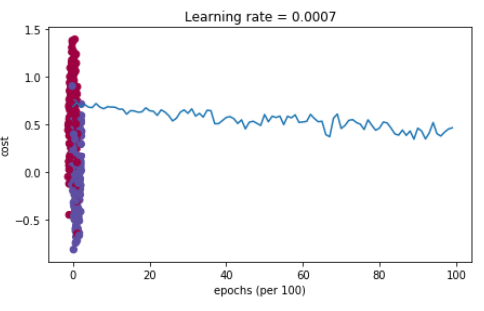

动量梯度下降
1 # train 3-layer model 2 layers_dims = [train_X.shape[0], 5, 2, 1] 3 parameters = model(train_X, train_Y, layers_dims, beta=0.9, optimizer="momentum") 4 5 # Predict 6 predictions = predict(train_X, train_Y, parameters) 7 8 # Plot decision boundary 9 plt.title("Model with Momentum optimization") 10 axes = plt.gca() 11 axes.set_xlim([-1.5, 2.5]) 12 axes.set_ylim([-1, 1.5]) 13 plot_decision_boundary(lambda x: predict_dec(parameters, x.T), train_X, train_Y)
预测准确率:0.797

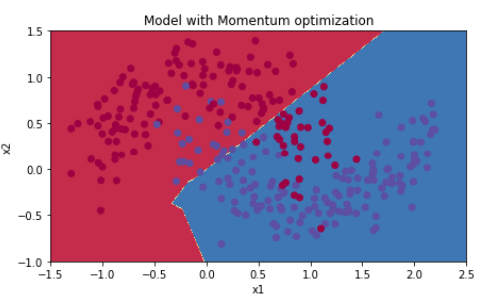
Adam梯度下降
1 # train 3-layer model 2 layers_dims = [train_X.shape[0], 5, 2, 1] 3 parameters = model(train_X, train_Y, layers_dims, optimizer="adam") 4 5 # Predict 6 predictions = predict(train_X, train_Y, parameters) 7 8 # Plot decision boundary 9 plt.title("Model with Adam optimization") 10 axes = plt.gca() 11 axes.set_xlim([-1.5, 2.5]) 12 axes.set_ylim([-1, 1.5]) 13 plot_decision_boundary(lambda x: predict_dec(parameters, x.T), train_X, train_Y)
预测准确度:0.94
